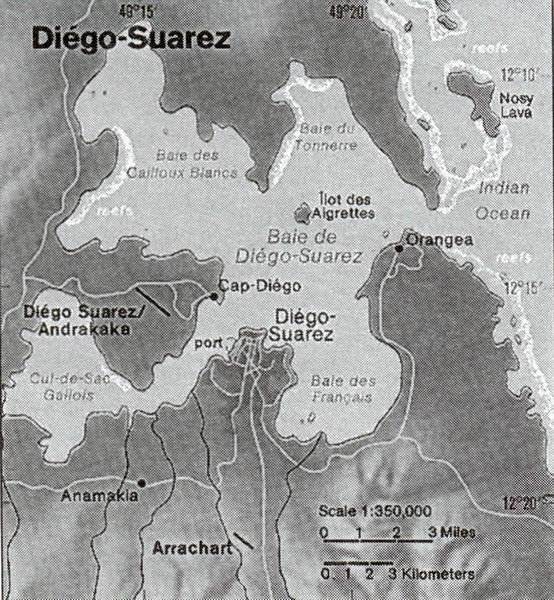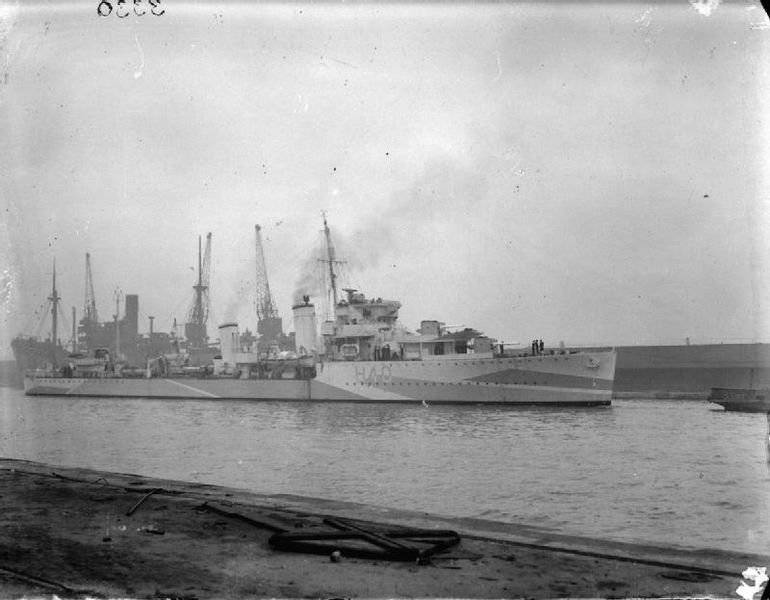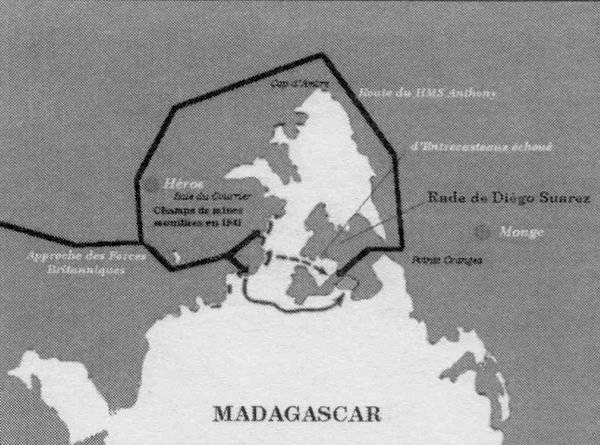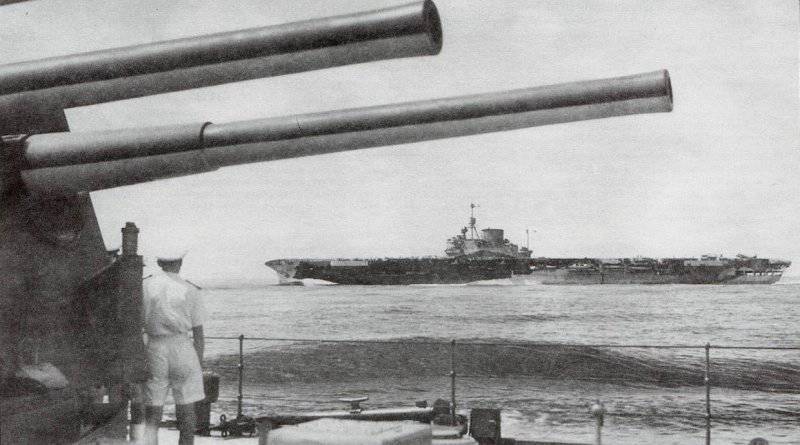Operation "Battleship". Part two
Three days later, the second Z convoy left the port, carrying five assault and three military vehicles, as well as the main strike forces of the operation: the battleship Ramillis, the aircraft carrier Illastries, the cruiser Hermione and six destroyers. Vice Admiral Neville Sifret and Airborne Force Commander Major General Robert Sturges were aboard the battleship. Both convoys merged and drifted at the latitude of Diego Suarez on May 3. Here, another Indomiteable aircraft carrier and two destroyers approached them from the north. These ships were transferred to Sifret from the Eastern Forces fleetoperating in the Indian Ocean.
Attention is drawn to the utmost caution with which the British command acted, despite the enormous advantage in forces. Obviously, the possible presence (or sudden appearance) of Japanese forces in this theater was taken into account. So, it was decided to land a landing not from the east - from the Gulf of Diego Suarez, but on the west coast. Closing it almost solid, in several rows, reef barriers required more time to disembark. In general, they made it extremely risky, but it was easier to detect enemy submarines here.
Diego-Suarez Bay has a narrow entrance from the east from the Indian Ocean - a strait half a mile wide, protected from the south by Fort Orange. And, besides, the edges of the strait are replete with reefs (they also make the northern shores of the bay unsuitable for shipboarding). The bay has four bays, diverging in all directions from the central lagoon. Actually Diego-Suarez is actually divided into two cities by a narrow internal strait leading into the south-western bay. The north-western part of the city (mostly poor neighborhoods of wooden buildings) is located on the peninsula of Andrakak. The administration, seaport and naval base is the southern part of the city - the Antsirana peninsula (Antsiranana), which gave the modern name to the city.
The main forces of the assault force (“commandos” from the Royal Marine Corps and the 29-I infantry brigade) were supposed to land on the Courier Bay, separated from the bay by a narrow isthmus. Their task was to rapidly seize the northwestern part of Diego-Suarez and the fort Cap Diego. Since the isthmus and the bay were mostly well-swept by coastal artillery, speed and surprise were the most important conditions for success.
Another landing force (17th brigade), reinforced tanks, had to land south - in the bay of Ambararat. His task was to seize the port and naval base. To do this, it was necessary to overcome a considerable distance (through forests and plantations, overcoming the possible resistance of the French troops) and break through to the southern outskirts of the city. And finally, the 13th brigade, smaller in number and the weakest in armament, was to land the second wave the next day on May 6, in order to support the main forces.
At the same time, part of the warships, having rounded Cape Amber (the northern tip of the island), were to approach the bay from the east.
At three o'clock in the afternoon of May 4, a hundred miles from Cape Amber, the main forces, following a signal from Ramillis, headed for the coast.
The cruiser Hermione went the fastest - he was supposed to conduct a demonstration in the morning of 5 using lighting and smoke projectiles on the opposite, east bank in order to divert the enemy’s attention from the actual landing site for a while.
On the night of May 5, the warships stopped at the outer barrier of the reefs, waiting for the backward transports. During this time, the destroyer "Laforey" was able in the dark to pass through a narrow winding passage between the reefs, which the French considered impossible, and marked the fairway. Behind him, Winchester Castle and other ships headed the landing craft of Courier Bay. Just before dawn, they stood at the shore, ready for disembarkation.
Despite the fact that at night minesweepers destroyed two mines from a barrier in the bay, their enemy explosions did not wake them up. The advanced commando group seized the old Fort Windsor Castle on the north shore of the bay with little or no resistance. His coastal battery (four 138-mm guns) was the greatest danger to the landing, after riffs and mines. The Commandos captured almost the entire garrison of the fort - about 300 people. The units of the 29 Brigade landed on the shore. The path to the opposite bank of the Diego-Suarez Bay was clear.
At the same time as the landing of the assault forces, the Fairy Albacore bombers took off from the decks of aircraft carriers. The main blow they inflicted on the airfield Arrashar. The Grumman F4F Wildcat (or Martlet) fighter-bombers who escorted them did not allow the French fighters to take to the air. They covered the landing area and stormed the location of anti-aircraft batteries. On the ground, five “Moran Sunier 406” and two “Pote 63-11” were destroyed. "Fairy Swordfish" in three groups of six cars attacked targets in the harbor of Diego Suarez. The first group (torpedo bombers), dispersed, began to circle in the dark over the port water area. First of all, they were interested in the D'Antrcasto advice note and the auxiliary cruiser Bougainville. The French sailors partly facilitated their task by opening fire from anti-aircraft guns, and thus finding the location of their ships. Four torpedoes, issued in the advice, passed by or under it, after which D'Antrcasto approached the coast under the cover of coastal anti-aircraft batteries. And “Bougainvillea” was unlucky - he got one hit, gave a lurch to the port side, and then exploded.

The second group, Suordfish, dropped deep-seated bombs and also achieved success, hitting the Bevezier submarine. The boat was removed from the anchor and maneuvered, submariners fired anti-aircraft fire. They were intensively supported by anti-aircraft gunners from the cargo transports standing nearby, but they did not manage to save the boat. Already after the attack, the Bevezier sank, eight people from its crew died.
The third group dumped leaflets with an ultimatum on the city, in which the word "honest gentlemanly" was given that the British have friendly intentions "and after the victory the island will be returned to France." However, after the flyers on the coastal batteries and moorings fell bombs.
Meanwhile, the entire first half of the day, the main forces of the landing force were concentrated on the shore of the Courier Bay. The transports continued to go through the main passage between the reefs. The minesweepers also cleared other fairways, but around noon the corvette "Orikjula" was blown up by a mine. (He sank the next day. It was the only ship of the British fleet lost during the operation.)
After that, the remaining units began to be transported to the coast by landing barges from an external raid. This circumstance, together with the increased wind, slowed down the landing (it lasted until the evening), but did not stop the units of the 29 Brigade, already ready to march - their number was about 2000 people. By May 17 5 watches, they occupied the north-western part of Diego-Suarez (Andrarac peninsula) - and again almost without resistance. Thus, the first landing fully performed its task in strict accordance with the plan of operation.
It was heavier than the second landing force, which landed to the south, in the bay of Ambararata. The landing itself went almost without difficulty and even faster than at the Courier.
The only delay was due to the “Bachakero”, or rather its ramp, which turned out to be too short (the coastal strip had unstable unstable soil with numerous depressions filled with water at high tide). Coming close to the shore of the bay, this transport managed to land only "Valentine". Cars and tractors with artillery guns could not overcome the unstable ground. In search of a suitable site the ship lost the whole day. In the end, the captain of "Bachakero" made a risky decision. He ordered at full speed rush to the shore. Subsequently, this case significantly influenced the design and tactics of using large landing ships, but this time it was the reason that the British heavy artillery lagged behind the main landing forces almost a day.
Already in 9.30, units of the 17 Brigade, reinforced with armored vehicles, began to move eastward along a single road, surrounded by wooded hills, very convenient for stopping the convoy or setting up an ambush. Fortunately for the British, the French did not have sufficient forces here. They rightly believed that to capture the southern part of Diego-Suarez, the British would be much more comfortable to land on the eastern shore. From there, first, closer, and second, the terrain is flatter.
Only in 11 hours a small detachment of guards, seeing the British advance on the road, opened fire. The terrain conditions allowed the French troops to detain the enemy for a long time, even with small forces, but the outcome of the collision was quickly decided by the Valentine. Tanks made a proper impression, forcing the defenders to fold weapon. The unexpected success that followed the successful landing made the English so self-confident that they were not afraid to reveal their location to the enemy. They sent a captive French officer to Diego-Suarez demanding immediate surrender. However, the commander of the garrison, Colonel Edwar Klerbu, was already engaged in organizing the defense of the southern part of the city and the naval base, despite the serious losses caused by the morning raid. Now, having learned which way the British were on, he managed to quickly arrange an ambush on their way. At this time, four light tank Mk VII, burst far ahead, were hit, and their crews were captured. By evening, the fashion show completely ceased to resemble a light walk. At the southern approaches to the city, the British reached a narrow place called Bon Nouvel, which was a narrowing watershed between swampy rivers that flow into the bay on both sides of the southern outskirts of the city. All the roads leading to Diego-Suarez from the depths of the island converged here between two forts.
Artillery would be very useful here, especially the four 94-millimeter howitzers, which at that time were just being taken ashore from Bachakero. But the French had here as two batteries of 75-millimeter field guns. Nevertheless, five "Valentine" broke through the space swept from the forts, but the infantry was cut off. As a result, these tankers were captured. Despite the arrival of the rest of the tanks, the British failed to advance before dark.

Meanwhile, D'Antrcasto, taking advantage of the lack of English aviation, began to shell the British position on the Andrakak peninsula. However, in the evening, “Swordfish” from the aircraft carrier “Illastries” unexpectedly appeared from the west over the bay and attacked advice notes with 227 kg bombs. Due to a direct hit, D'Antrcasto was forced to throw himself ashore. Then there were two more raids, but the crew left the ship only the next day, after artillery shelling from the destroyer Laforei.
All this day, French aviation practically did not offer any resistance, except for reconnaissance flights, during which two aircraft were lost. The losses of the British carrier-based aviation also amounted to two cars: one Albacore and one Suordfish were shot down over the bay and their crews were captured.
At night, using the darkness, the destroyer "Anthony" was able to enter the bay and land several dozen commandos in the port. They managed to free the pilots and they returned home in the morning.
At dawn on the 6 in May, the 29 Brigade, reinforced by parts of the 17 Brigade that approached the night, resumed the assault on the French positions in Bon Nouvelle. Bloody battles and artillery duels continued throughout the day, but due to the fact that the British had to attack almost in the forehead no noticeable result was achieved. The Albacores, who bombed the forts several times a day, did not help either. Two battalions of the South Lancashire regiment managed to get around Bon Nouvel from the left flank, having infiltrated through the swampy jungle. But because of the malfunction of the radio, they could not develop success and were forced to return, having suffered losses.
The paratroopers who occupied the north-western part of Diego-Suarez were also unable to provide support to the attackers. The strait separating the city turned out to be an insurmountable obstacle for them due to the fire of coastal batteries.
The only success of the English on this day can be considered three "Pote 63-11", shot down over the bay.
Only successful actions of commandos could provide a way out of the existing equilibrium. In English sources it is usually indicated that it was they who ultimately decided the outcome of the operation.
Indeed, in the evening, "Anthony" with fifty commandos on board again managed to get into the bay. This time it was shelled by the coastal batteries, but the British again managed to land troops and even destroy the only searchlight of the French. After that, the destroyer left at full speed, and the paratroopers staged indiscriminate firing at the piers. Having lost only one person, they penetrated deep into the deserted city and seized the arsenal building. In addition to a large number of weapons and ammunition, the marines found and freed there about fifty British prisoners. This brilliant operation led to the confusion of the French and is believed to have forced them to surrender. However, at the same time, the British launched a night attack on Bon-Nouvel. Suddenly, the French (that is, mainly Malgashi) ceased resistance, although they did not know about the captured arsenal. The true reason for which they suddenly didn’t want to fight is still unknown. But, anyway, by 3 hours of the morning 7 in May the port city and naval base were completely captured, the army and naval commanders of the French surrendered. Resistance during the day provided only a few small garrisons of the forts on the shores of the bay.
In describing all of these events, British sources avoid the details of the two night raids of the destroyer Anthony to a well-guarded port, as well as with the successful landing of commandos. Obviously, the British command had, at a minimum, a French secret fairway map, and possibly its own people in the garrison. The fact is that the destroyer needed not only to walk for a quarter of a mile in view of the battery of Fort Orange, and then come close to the coastal batteries guarding the port, but also to avoid minefields. (By the way, Orangay capitulated with one of the last 7s in the evening in May, and only after Ramillis approached the shore and made several shots of the main caliber for the fortifications of the fort.) Thus, the British secret services in this operation also turned out to be height. Note that after the surrender of all the French garrisons, the British spent two days trawling the bay, the straits and the approaches to the bay. And even after that, at first, the Polish transport Sobesski was first pushed in (the Poles, for some reason, are very proud of it), and the rest ships came after it.
The fate of two other French submarines was tragic. At the time of the British landing, Le Hero was on the open sea 500 miles from Madagascar, escorting transports to Djibouti. Having received a radiogram about the beginning of the invasion, the submarine lay on the opposite course. On the morning of May 7 in the area of Courier Bay “Le Herault” attacked the aircraft carrier Illustries from the surface position, but it was discovered by Soordfish, which carried out anti-submarine patrols. The boat went too late for an urgent dive and was seriously damaged. A fitted Jenista corvette picked up submariners from the 37 water, the remaining 24 drowned or were eaten by sharks.
The third Monge submarine returned to the combat area only on May 8 from Reunion Island. Her crew did not know about the invasion, but, finding the enemy ships, also attacked the Illustries. Destroyers rushed towards the "Active" and "Panther". They accurately hit the target depth charges. No one escaped from the 69 crew members.

During the fighting under Diego-Suarez, the French side lost 167 people killed and missing (among them 119 sailors) and 343 wounded. The already weak forces of the French aviation were virtually destroyed: the British shot down or destroyed sixteen Moran-Saulnier 406 and four or five Pote 63-11 in the stands. The same fate befell the available forces of the French fleet. The losses amounted to auxiliary cruiser, an advice and three submarines. The advice d'Iberville and the fourth submarine “la Glorieux” managed to break through to bases in the southern part of Madagascar, and then went to Toulon.
During the three days of fighting, the British lost about 100 killed and 300 wounded, four aircraft and one corvette.
So British control over the port and base Diego-Suarez was established. The fighting on the rest of the island of Madagascar with significant interruptions continued for another six months. Despite the hopelessness of the resistance, Governor Armand Leon Anne rejected proposals for surrender and joining the Free French. In the summer, additional units of the South African British Army were transferred to the island, and they had to carry out grueling combat operations against the partisans. Finally, the French administration capitulated only on November 5. But all these events on the island no longer had a significant impact on the course of the war. Much more important was the need to keep in Madagascar impressive naval forces, far exceeding any landing needs for support from the sea. These ships, of course, were very necessary in other theaters. But the desire to preempt a possible Japanese invasion forced the British command to hold a powerful squadron here. The appearance of Japanese submarines in the summer off the coast of Mozambique seemed to confirm these fears. (One Japanese torpedo even hit the Remillis parked in the bay, but it did not sink.) However, the French did not wait for the approach of large forces and the landing of the Japanese.
And in conclusion, we will repeat that this was the first in the Second World War classic operation on the landing of troops, equipped with tanks and artillery, on an unequipped coast. Subsequently, Churchill wrote about her like this:
“According to the secrecy that surrounded his planning, and to the accuracy of tactical execution, the Madagascar episode was an example of a combined landing operation. The news of him came at a time when we were in dire need of success. In fact, for many months this episode was the only example of good and skillful leadership of the war. ”

Information